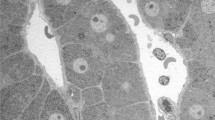Abstract
Apoptosis plays a major role in the regression of mitogen (lead nitrate)-induced hepatic hyperplasia. We compared the in situ end-labeling (ISEL) technique with the conventional detection of apoptotic bodies in this process. In hematoxylin and eosin (H&E) sections, apoptosis is usually recognizable by the presence of apoptotic bodies (apoptosis phase 2). Although the early phase of apoptosis (apoptosis phase 1) can be detected as a prekaryorrhectic appearance in H&E sections, it is difficult to detect and is easily overlooked. On the other hand, ISEL presents intense staining mainly in phase 1 and weak or negative staining in phase 2. Thus, simultaneous investigation by these two methods in two serial sections is the most reliable way to calculate the incidence of apoptosis and gives us precise information on the stages of apoptosis in situ. Since the colorized signals of ISEL are much easier to detect than apoptotic bodies in H&E sections, ISEL is particularly useful for liver tissues, where the incidence of apoptosis is low.
Similar content being viewed by others
References
Leevy CM. In vitro studies of human hepatic DNA synthesis in percutaneous liver biopsy specimens. J Lab Clin Med 1963; 61:761–779.
Gratzner HG. Monoclonal antibody to 5-bromo and 5-iododeoxyuridine: A new reagent for detection of DNA replication. Science 1982;218:474–476.
Hamada S. A double labeling technique combining3H-thymidine autoradiography with BrdU immunohistochemistry. Acta Histochem Cytochem 1985;18:267–270.
Namikawa R, Ueda R, Suchi T, et al. Double immunoenzymatic detection of surface phenotype of proliferating lymphocytes in situ with monoclonal antibodies against DNA polymerase alpha and lymphocyte membrane antigens. Am J Clin Pathol 1987;87:725–731.
Hall PA, Richards MA, Gregory WM, et al. The prognostic value of Ki-67 immunostaining in non-Hodgkin's lymphoma. J Pathol 1988;154:223–235.
Garcia RL, Coltrera MD, Gown AM. Analysis of proliferating grade using anti-PCNA/cyclin monoclonal antibodies in fixed, embedded tissues. Comparison with flow cytometric analysis. Am J Pathol 1989;134:733–739.
Cattoretti G, Becker MHG, Key G, et al. Monoclonal antibodies against recombinant parts of the Ki-67 antigen (MIB 1 and MIB 3) detect proliferating cells in microwave-processed formalinfixed paraffin sections. J Pathol 1992;168:357–363.
Kerr JFR, Searle J, Bishop CJ. Apoptosis: A distinctive mode of cell death that plays an opposite role to mitosis in cell population kinetics. Australas Radiol 1979;23:192–201.
Cotter TG, Lennon SV, Glynn JG, Martin SJ. Cell death via apoptosis and its relationship to growth, development and differentiation of both tumor and normal cells. Anticancer Res 1990;10:1153–1159.
Kerr JFR, Wyllie AH, Currie AR. Apoptosis: A basic biological phenomenon with wide-ranging implications in tissue kinetics. Br J Cancer 1972;26:239–257.
Bursch W, Taper HS, Lauer B, Schulte-Hermann R. Quantative histological and histochemical studies on the occurrence and stages of controlled cell death (apoptosis) during regression of rat liver hyperplasia. Virchows Arch [A] 1985;50:153–166.
Gavrieli Y, Sherman Y, Ben-Sasson SA. Identification of programmed cell death in situ via specific labeling of nuclear DNA fragmentation. J Cell Biol 1992;119:493–501.
Wijsman JH, Jonker RR, Keijzer R, et al. A new method to detect apoptosis in paraffin sections: In situ end-labeling of fragmented DNA. 1993;41:7–12.
Ansari B, Coates PJ, Greensein BD, Hall PA. In situ end-labelling detects DNA strand breaks in apoptosis and other physiological and pathological states. J Pathol 1993;170:1–8.
Columbano A, Ledda GM, Sirigu P, et al. Liver cell proliferation induced by a single dose of lead nitrate. Am J Pathol 1983; 110:83–88.
Hikita H, Kagawa K, Okanoue T, et al. Cell analysis of liver hyperplasia induced by lead nitrate (in Japanese). Acta Hepatol Jpn 1990;31:653–659.
Duke RC, Chervenak R, Cohen JJ. Endogenous endonuclease-induced DNA fragmentation: An early event in cell-mediated cytolysis. Proc Natl Acad Sci USA 1983;80:6361–6365.
Arends MJ, Morris RG, Wyllie AH. Apoptosis:; The role of the endonuclease. 1990;136:593–608.
Wyllie AH, Morris RG, Smith AL, Dunlop D. Chromatin cleavage in apoptosis: Association with condensed chromatin morphology and dependence on macromolecular synthesis. J Pathold 1984;142:67–77.
Wyllie AH. Apoptosis. Immunology 1988;1:192–196.
Bursch W, Paffe S, Putz B, et al. Determination of the length of the histological stages of apoptosis in normal liver and in altered hepatic foci of rats. Carcinogenesis 1990;11:847–853.
Author information
Authors and Affiliations
Rights and permissions
About this article
Cite this article
Nakajima, T., Deguchi, T., Kagawa, K. et al. Identification of apoptotic hepatocytes in situ in rat liver after lead nitrate administration. J Gastroenterol 30, 725–730 (1995). https://doi.org/10.1007/BF02349638
Received:
Accepted:
Issue Date:
DOI: https://doi.org/10.1007/BF02349638




